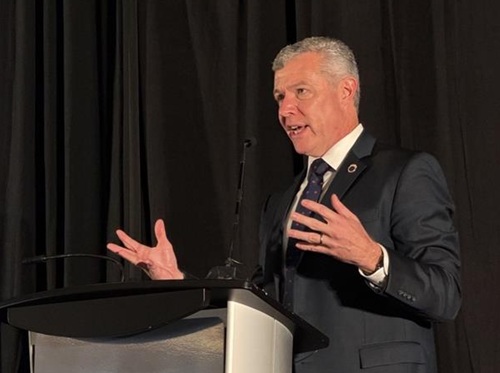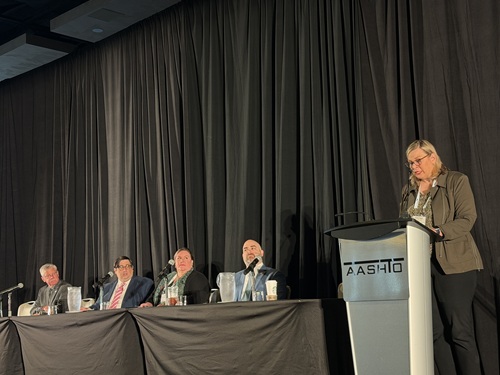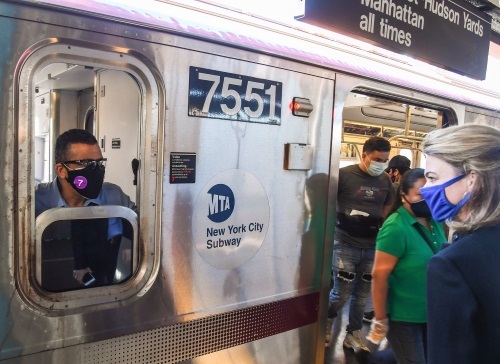The Centers for Disease Control and Prevention recently issued a “strong recommendation” for public transportation passengers and transit operators alike to wear masks in order to prevent spread of the virus that causes COVID-19.
[Above photo by the Metropolitan Transportation Authority.]
The agency said passengers on “public conveyances” – such as airplanes, ships, ferries, trains, subways, buses, taxis, ride-shares – should follow its mask-wearing recommendation, as well as the operators of those conveyances – the crew, drivers, conductors, and other workers involved in their operation.

“Face masks help prevent people who have COVID-19, including those who are pre-symptomatic or asymptomatic, from spreading the virus to others,” the CDC said in its guidance update. “Masks are most likely to reduce the spread of COVID-19 when they are widely used by people in public settings.”
The agency added that wider use of masks especially helps protect those at higher risk of severe illness from COVID-19 as well as workers who frequently come into close contact with other people at airports, seaports or other docks, bus terminals, and train stations.
“Using masks along with other preventive measures, including social distancing, frequent hand hygiene, and cleaning and disinfecting frequently touched surfaces, is one of the most effective strategies available for reducing COVID-19 transmission,” the agency said.

On top of that, a report issued in early October by the Sam Schwartz transportation-engineering firm on behalf of the American Public Transportation Association indicates that there is “no direct correlation” between use of urban public transit and transmission of the COVID-19 virus.
The 35-page report – entitled Public Transit and COVID-19 Pandemic: Global Research and Best Practices – analyzed the latest scientific evidence on how the COVID-19 virus spreads compared to ridership and infection rates in multiple U.S. cities, as well as the impact of various mitigation measures for controlling viral spread. Its analysis found no direct links between transit and infection rates.
“A review of studies from around the world indicate minimal risk from using public transit, especially where specific safeguards are in place, such as face coverings, well-functioning ventilation systems, and minimal talking by riders,” the report said.

The APTA has also launched a national “Health and Safety Commitments Program” for transit agencies during a virtual event on September 9 – a safety program designed to assure passengers that public transit systems are “taking all the necessary measures to operate safely” as the nation recovers from the COVID-19 pandemic.
“The program [we’ve] launched is the public transportation industry’s pledge to promote sensible policies and practices designed to keep transit users and transit employees safe during the COVID-19 crisis,” explained Paul Skoutelas, APTA’s president and CEO, during the virtual event.
Meanwhile, a test conducted by the U.S. Transportation Command indicates that the overall exposure risk from aerosolized pathogens such as COVID-19 “is very low” on Boeing 767-300 and 777-200 commercial aircraft – the airplane models the command uses to move Department of Defense personnel and their families.

That test – dubbed the Commercial Aircraft Cabin Aerosol Dispersion Test and conducted in August – revealed that the test aerosol released into the aircraft’s passenger compartment became “rapidly diluted” by the high air exchange rates observed in the airframes in less than six minutes. For comparison, a typical American home takes around 90 minutes to clear these types of particles from the air, U.S. Transcom said.
That high air exchange coupled with high efficiency particulate air or HEPA filtration of all recirculated air, means a commercial aircraft’s air supply system provides protection greater than the design standards for a patient isolation room or a hospital operating room.
“While the tests did have some limitations, specifically it only considered a single infected passenger and did not attempt to gather data reflecting passenger movement about the cabin, the results are encouraging,” explained Commander Joe Pope, U.S. Transcom operations directorate liaison for the testing in a statement.
“For both the 777 and 767 airframes, the calculations show about 54 flight hours are required for cumulative inhalation of an assumed infectious dose,” he said.
 Top Stories
Top Stories
Collaboration Touted at AASHTO’s Third Safety Summit
October 31, 2025 Top Stories
Top Stories

